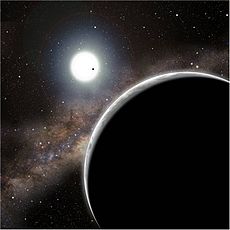|
ケプラー19
ケプラー19(英語: Kepler-19)は、地球から見てこと座の方向に約720光年離れた位置にある、太陽よりやや小さい恒星である。3個の太陽系外惑星が周囲を公転していることが知られている。 惑星系2011年、ケプラー宇宙望遠鏡によるトランジット法での観測によって、地球の約2.2倍の大きさを持つ太陽系外惑星ケプラー19bが発見された[3]。ケプラー19bの公転周期は9日余りであるが、その公転周期自体が316日の周期で5分程度変動するというトランジットタイミング変化 (TTV) が観測された事から、その外側を公転している、主星の手前を通過(トランジット)しない別の惑星からの重力の影響を受けていることが判明し、この外側を公転する惑星はケプラー19cと呼称された[3][5]。トランジットタイミング変化を用いた観測により新たな惑星の存在が確かめられた事例はこのケプラー19cが初めてである[6]。当初はケプラー19cの質量は木星の6倍未満、公転周期は160日未満という大まかな特性しか求められず、5日周期で公転する地球型惑星や100日周期で公転する巨大ガス惑星などである可能性が示されていた[3][5]。 2017年にドップラー分光法による観測からさらに外側を公転している新たな惑星ケプラー19dの存在が確認され、この研究によりケプラー19cの質量も地球の約13倍であると求められた[7]。
脚注注釈出典
関連項目外部リンク
|
|||||||||||||||||||||||||||||||||||||||||||||||||||||||||||||||||||||||||||||||||||||||||||
Index:
pl ar de en es fr it arz nl ja pt ceb sv uk vi war zh ru af ast az bg zh-min-nan bn be ca cs cy da et el eo eu fa gl ko hi hr id he ka la lv lt hu mk ms min no nn ce uz kk ro simple sk sl sr sh fi ta tt th tg azb tr ur zh-yue hy my ace als am an hyw ban bjn map-bms ba be-tarask bcl bpy bar bs br cv nv eml hif fo fy ga gd gu hak ha hsb io ig ilo ia ie os is jv kn ht ku ckb ky mrj lb lij li lmo mai mg ml zh-classical mr xmf mzn cdo mn nap new ne frr oc mhr or as pa pnb ps pms nds crh qu sa sah sco sq scn si sd szl su sw tl shn te bug vec vo wa wuu yi yo diq bat-smg zu lad kbd ang smn ab roa-rup frp arc gn av ay bh bi bo bxr cbk-zam co za dag ary se pdc dv dsb myv ext fur gv gag inh ki glk gan guw xal haw rw kbp pam csb kw km kv koi kg gom ks gcr lo lbe ltg lez nia ln jbo lg mt mi tw mwl mdf mnw nqo fj nah na nds-nl nrm nov om pi pag pap pfl pcd krc kaa ksh rm rue sm sat sc trv stq nso sn cu so srn kab roa-tara tet tpi to chr tum tk tyv udm ug vep fiu-vro vls wo xh zea ty ak bm ch ny ee ff got iu ik kl mad cr pih ami pwn pnt dz rmy rn sg st tn ss ti din chy ts kcg ve
Portal di Ensiklopedia Dunia


